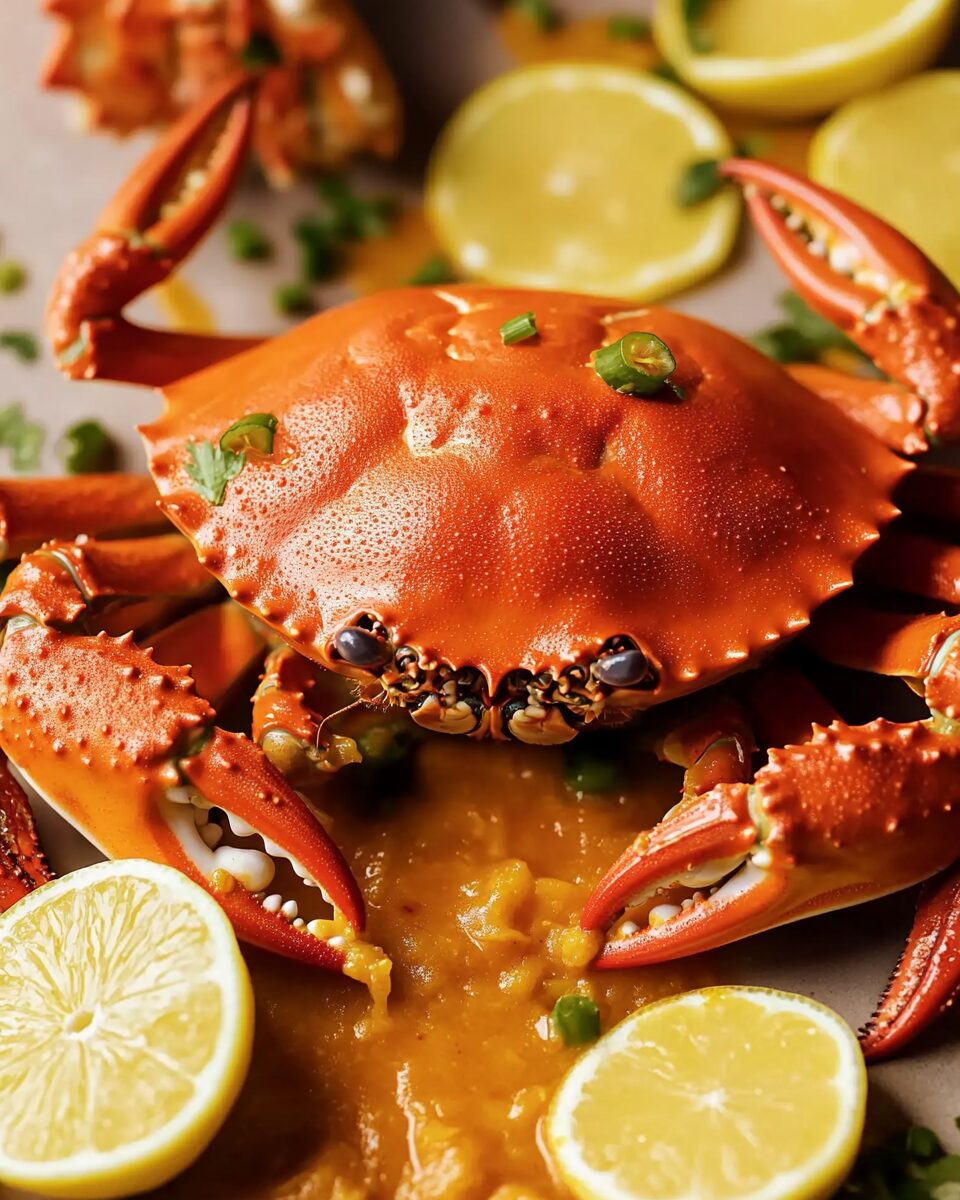Singapore Chilli Crab is a vibrant, saucy seafood dish that marries the sweetness of fresh crab with a perfectly balanced spicy, tangy tomato-chili sauce. The bright red shells coated in glossy, rich sauce make it as visually enticing as it is delicious.
This dish is both a celebration of Singapore’s rich culinary heritage and an indulgent treat for any seafood lover. It’s ideal for sharing at family dinners or special occasions, offering a hands-on experience with bold flavors and a satisfying, comforting texture.
Full Recipe:
-
2 whole mud crabs (about 1.5kg), cleaned and cut into pieces
-
3 tablespoons vegetable oil
-
1 large onion, finely chopped
-
4 cloves garlic, minced
-
2-inch piece ginger, minced
-
2 fresh red chilies, chopped (adjust to taste)
-
3 tablespoons tomato ketchup
-
2 tablespoons chili sauce (such as Sriracha or a good Asian chili sauce)
-
1 tablespoon soy sauce
-
1 tablespoon oyster sauce
-
1 tablespoon sugar
-
1 teaspoon white pepper
-
1 cup chicken stock or water
-
2 eggs, lightly beaten
-
1 tablespoon cornstarch mixed with 2 tablespoons water (optional, for thickening)
-
Fresh coriander leaves for garnish
-
Lime wedges for serving
Directions:
-
Heat oil in a large wok or deep pan over medium-high heat. Add onion, garlic, ginger, and chilies. Stir-fry until fragrant and softened, about 2-3 minutes.
-
Stir in ketchup, chili sauce, soy sauce, oyster sauce, sugar, and white pepper. Cook for 1-2 minutes to blend flavors.
-
Add chicken stock or water, bring to a simmer.
-
Add crab pieces, cover and cook for about 8-10 minutes until crab shells turn bright red and meat is cooked through. Stir occasionally to coat crab in sauce.
-
Slowly pour in beaten eggs while stirring gently to create silky ribbons in the sauce.
-
If you want a thicker sauce, stir in cornstarch slurry and cook until sauce thickens.
-
Garnish with fresh coriander and serve immediately with lime wedges on the side.
Prep Time: 20 minutes | Cooking Time: 20 minutes | Total Time: 40 minutes
Kcal: approx. 450 kcal per serving | Servings: 4 servings
The Origin and Cultural Significance of Singapore Chilli Crab
Singapore Chilli Crab is one of the most iconic dishes in Singapore’s vibrant culinary scene, often hailed as a national treasure. This dish is beloved not only locally but also internationally, representing the perfect marriage of fresh seafood with a rich, spicy sauce that is uniquely Southeast Asian. It was first created in the 1950s by a humble hawker named Cher Yam Tian, who experimented with crabs cooked in a tomato and chili-based sauce. Over time, the recipe evolved and gained immense popularity, becoming a must-try for visitors and locals alike. The dish embodies the multicultural influences in Singapore cuisine—drawing on Chinese, Malay, and Peranakan flavors to create a harmonious balance of sweet, spicy, and savory notes.
The Flavor Profile and What Makes It Special
What makes Singapore Chilli Crab stand out is its distinct sauce, which is the soul of the dish. The sauce masterfully balances sweetness from tomato ketchup, the fiery heat of fresh chilies, and the umami depth from soy and oyster sauces. The inclusion of lightly beaten eggs stirred into the sauce creates a silky texture that clings to every crab piece, elevating the dish beyond ordinary seafood recipes. This rich, luscious sauce is the perfect companion to the naturally sweet and succulent meat of mud crabs, making every bite an exciting experience for the palate.
Why Mud Crab Is the Preferred Choice
Mud crab is the crab of choice for this dish because of its large size and firm, sweet meat. Unlike smaller crabs, mud crabs provide plenty of meat in their claws and legs, making them ideal for this saucy preparation. Their natural sweetness complements the spicy and tangy sauce beautifully. When fresh and properly cooked, the crab meat remains tender, juicy, and flavorful, offering a delightful contrast to the robust sauce. Using live or very fresh mud crab is key to achieving the authentic taste and texture that defines Singapore Chilli Crab.
The Importance of Technique in Cooking Chilli Crab
Though this recipe may seem straightforward, technique plays an important role in delivering the best result. Sautéing aromatics like garlic, ginger, and fresh chilies properly unlocks the base flavors essential to the sauce. Timing is critical when cooking the crab — overcooking can make the meat tough and dry, while undercooking will leave it raw and unpleasant. Incorporating the eggs at the right moment, while stirring gently, allows the sauce to thicken and develop its signature silky strands. This attention to detail separates a restaurant-quality dish from an average homemade attempt.
Serving Suggestions and Accompaniments
Singapore Chilli Crab is best served hot and fresh, ideally with simple accompaniments that complement but don’t overpower the dish. Traditionally, it’s enjoyed with steamed white rice or deep-fried mantou buns. The buns are perfect for dipping into the flavorful sauce, soaking up every bit of the spicy goodness. Additionally, a refreshing cucumber salad or a side of stir-fried greens helps balance the richness of the crab. Many diners enjoy wiping their fingers clean with lime wedges, which add a fresh citrus tang that cuts through the sauce’s richness.
Variations and Modern Twists
While the classic Singapore Chilli Crab remains a staple, modern chefs and home cooks have created numerous variations. Some add tamarind or lime juice for extra tanginess, while others experiment with the heat level by incorporating different types of chilies or chili pastes. Some versions include coconut milk for a creamy touch or substitute the crab with other shellfish like prawns or lobster to cater to different tastes. However, no matter the tweaks, the essence of the dish lies in maintaining that perfect balance between sweet, spicy, and savory flavors with a luxurious texture.
Health Considerations
While undeniably delicious, Singapore Chilli Crab is a rich dish due to its use of sauces, sugar, and eggs. However, it also offers nutritional benefits. Crab meat is a great source of lean protein, vitamins, and minerals like zinc and selenium, which support immune health. The chili peppers in the sauce can boost metabolism and provide antioxidants. To keep the dish balanced, serving it with plenty of fresh vegetables or greens is recommended. Moderation is key, especially if watching sodium or sugar intake, as sauces like soy and ketchup contribute to the overall salt and sugar content.
Tips for Making Singapore Chilli Crab at Home
Recreating this iconic dish at home might seem intimidating, but with some insider tips, it can be an enjoyable cooking adventure. Using fresh crabs is crucial; if live crabs aren’t available, buy whole crabs that are fresh and properly cleaned. Prepare all ingredients ahead since the cooking process is fast once started. Use a wok or large deep pan to provide enough room for tossing and coating the crab evenly. Adjust the spice level to your preference by controlling the amount and type of chilies used. Lastly, don’t rush the egg swirling step, as this gives the sauce its signature velvety finish.
The Social and Communal Aspect of Eating Chilli Crab
Singapore Chilli Crab is not just about flavor—it is also about experience. Eating this dish is famously messy, with hands-on cracking and dipping that encourages communal dining and sharing. It’s often enjoyed in lively settings, from hawker centers to upscale seafood restaurants, bringing people together over a shared love of bold flavors and fresh seafood. The process of eating crab—cracking shells, peeling meat, and licking fingers—is part of the fun and intimacy of the meal, making it an unforgettable social experience.
Conclusion
Singapore Chilli Crab stands as a shining example of Singapore’s rich culinary heritage, blending bold flavors, fresh ingredients, and a hands-on eating style into one unforgettable dish. Its enduring popularity stems not only from its complex, mouthwatering taste but also from the joyful, communal experience it fosters at the dining table. Whether enjoyed at a bustling hawker stall or made from scratch at home, this dish continues to captivate food lovers worldwide, inviting everyone to savor the best of Singapore’s coastal bounty with every saucy bite. Mastering this recipe offers a delicious gateway into Southeast Asian cuisine and a taste of Singapore’s vibrant food culture.





